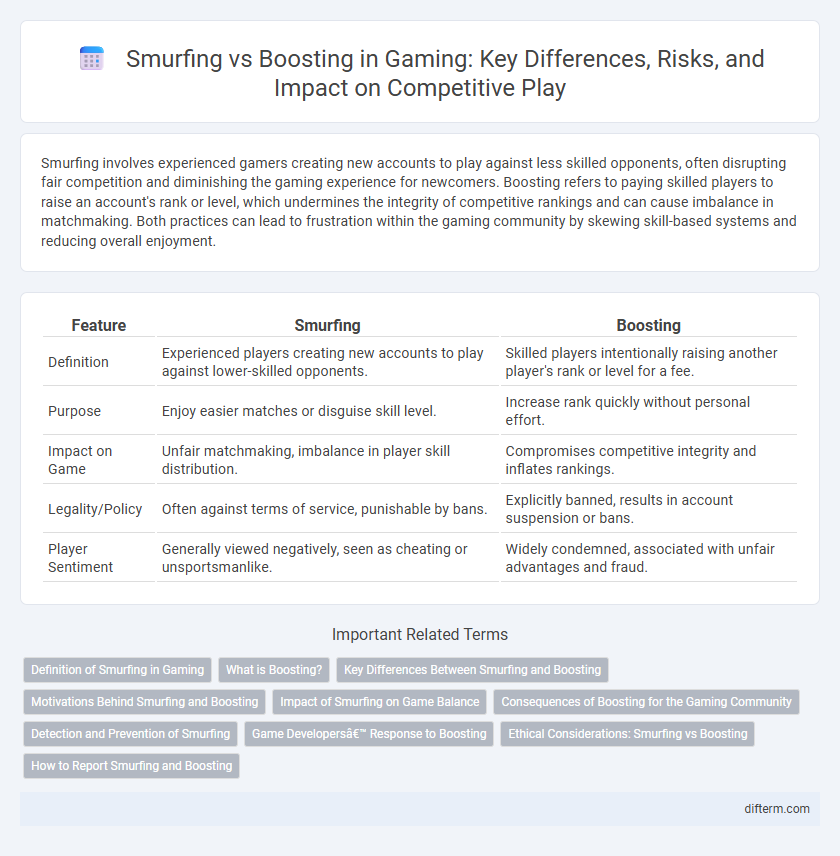Smurfing involves experienced gamers creating new accounts to play against less skilled opponents, often disrupting fair competition and diminishing the gaming experience for newcomers. Boosting refers to paying skilled players to raise an account's rank or level, which undermines the integrity of competitive rankings and can cause imbalance in matchmaking. Both practices can lead to frustration within the gaming community by skewing skill-based systems and reducing overall enjoyment.
Table of Comparison
| Feature | Smurfing | Boosting |
|---|---|---|
| Definition | Experienced players creating new accounts to play against lower-skilled opponents. | Skilled players intentionally raising another player's rank or level for a fee. |
| Purpose | Enjoy easier matches or disguise skill level. | Increase rank quickly without personal effort. |
| Impact on Game | Unfair matchmaking, imbalance in player skill distribution. | Compromises competitive integrity and inflates rankings. |
| Legality/Policy | Often against terms of service, punishable by bans. | Explicitly banned, results in account suspension or bans. |
| Player Sentiment | Generally viewed negatively, seen as cheating or unsportsmanlike. | Widely condemned, associated with unfair advantages and fraud. |
Definition of Smurfing in Gaming
Smurfing in gaming refers to experienced players creating new accounts to play against less skilled opponents, often to gain easy wins or avoid competitive pressure. This practice impacts matchmaking systems by skewing skill ratings and can disrupt fair play in online multiplayer games. Smurfing differs from boosting, where one player compensates another to raise their rank artificially.
What is Boosting?
Boosting in gaming involves a skilled player improving another player's rank or level by playing on their account or alongside them, often violating game terms of service. This practice undermines competitive integrity by artificially inflating ranks without genuine skill progression. Game developers implement anti-boosting measures to maintain fair matchmaking and preserve player experience.
Key Differences Between Smurfing and Boosting
Smurfing involves experienced players creating new accounts to play against lower-skilled opponents, aiming for easier wins and faster rank progression. Boosting occurs when a higher-ranked player plays on someone else's account or provides services to increase that player's rank artificially. The key difference lies in smurfing being self-initiated for personal play advantage, while boosting is often a paid service impacting competitive integrity.
Motivations Behind Smurfing and Boosting
Players engage in smurfing to experience easier gameplay and quickly achieve high ranks without the pressure of their main account's skill level. Boosting is primarily motivated by the desire for rapid rank advancement and access to exclusive rewards or status symbols without investing the necessary time or effort. Both practices reflect a pursuit of achievement and recognition within gaming communities, often at the cost of fair competition.
Impact of Smurfing on Game Balance
Smurfing disrupts game balance by introducing highly skilled players into lower-ranked matches, which skews competitive fairness and frustrates legitimate players. This manipulation inflates matchmaking ratings inaccurately, causing unbalanced team compositions and deteriorating the overall gaming experience. Persistent smurfing can lead to higher player churn rates as newcomers face disproportionate challenges against veteran opponents.
Consequences of Boosting for the Gaming Community
Boosting undermines fair competition by creating skill disparities that distort matchmaking and frustrate genuine players. It devalues player achievements, leading to reduced trust in ranking systems and diminished overall game integrity. Persistent boosting can result in stricter enforcement policies, including account suspensions and bans, impacting community cohesion and player retention.
Detection and Prevention of Smurfing
Detection of smurfing in gaming relies heavily on pattern analysis of player behavior, including drastic skill level variances and unusual matchmaking statistics. Prevention techniques incorporate account verification, such as phone or email authentication, and implementing machine learning algorithms to identify and flag suspicious account activities. Game developers enhance fairness and competitive integrity by continuously updating detection systems and encouraging community reporting mechanisms to mitigate smurfing impact effectively.
Game Developers’ Response to Boosting
Game developers have implemented sophisticated anti-boosting measures such as automated detection systems and account suspensions to curb the rise of boosting in competitive gaming. These measures include real-time monitoring of irregular gameplay patterns and cross-referencing player statistics to identify unnatural skill improvements. Continuous updates to matchmaking algorithms aim to maintain fair play by reducing the impact of boosted accounts on game balance and player experience.
Ethical Considerations: Smurfing vs Boosting
Smurfing in gaming involves experienced players creating new accounts to play against less skilled opponents, which can disrupt fair competition and diminish the gaming experience for newcomers. Boosting refers to paying or collaborating with higher-skilled players to artificially increase a player's rank, undermining the integrity of competitive rankings. Both practices raise ethical concerns by compromising fairness, trust, and the overall health of gaming communities.
How to Report Smurfing and Boosting
To report smurfing and boosting in gaming, access the in-game reporting system usually found in the player's profile or match summary screen. Provide detailed evidence such as suspicious gameplay patterns, inconsistent skill levels, or explicit admission from players involved. Submitting accurate reports helps maintain fair matchmaking and improves overall game integrity.
smurfing vs boosting Infographic

 difterm.com
difterm.com